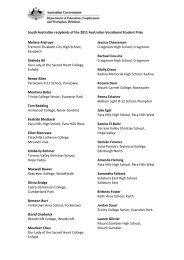Belonging, Being and Becoming - Early Years Learning Framework
Belonging, Being and Becoming - Early Years Learning Framework
Belonging, Being and Becoming - Early Years Learning Framework
Create successful ePaper yourself
Turn your PDF publications into a flip-book with our unique Google optimized e-Paper software.
LEARNING OUTCOMES<br />
OUTCOME 5: CHILDREN ARE EFFECTIVE COMMUNICATORS<br />
Children interact verbally <strong>and</strong> non-verbally with others for a range of purposes<br />
This is evident, for example,<br />
when children:<br />
• engage in enjoyable interactions using<br />
verbal <strong>and</strong> non-verbal language<br />
• convey <strong>and</strong> construct messages with purpose<br />
<strong>and</strong> confi dence, building on home/family <strong>and</strong><br />
community literacies<br />
• respond verbally <strong>and</strong> non-verbally to what<br />
they see, hear, touch, feel <strong>and</strong> taste<br />
• use language <strong>and</strong> representations from play,<br />
music <strong>and</strong> art to share <strong>and</strong> project meaning<br />
• contribute their ideas <strong>and</strong> experiences in<br />
play, small <strong>and</strong> large group discussions<br />
• attend <strong>and</strong> give cultural cues that they are<br />
listening to <strong>and</strong> underst<strong>and</strong>ing what is said to<br />
them<br />
• are independent communicators who initiate<br />
St<strong>and</strong>ard Australian English <strong>and</strong> home language<br />
conversations <strong>and</strong> demonstrate the ability to<br />
meet the listeners’ needs<br />
• interact with others to explore ideas <strong>and</strong><br />
concepts, clarify <strong>and</strong> challenge thinking,<br />
negotiate <strong>and</strong> share new underst<strong>and</strong>ings<br />
• convey <strong>and</strong> construct messages with purpose<br />
<strong>and</strong> confi dence, building on literacies of<br />
home/family <strong>and</strong> the broader community<br />
• exchange ideas, feelings <strong>and</strong> underst<strong>and</strong>ings<br />
using language <strong>and</strong> representations in play<br />
• demonstrate an increasing underst<strong>and</strong>ing of<br />
measurement <strong>and</strong> number using vocabulary<br />
to describe size, length, volume, capacity <strong>and</strong><br />
names of numbers<br />
• express ideas <strong>and</strong> feelings <strong>and</strong> underst<strong>and</strong> <strong>and</strong><br />
respect the perspectives of others<br />
• use language to communicate thinking about<br />
quantities to describe attributes of objects<br />
<strong>and</strong> collections, <strong>and</strong> to explain mathematical<br />
ideas<br />
• show increasing knowledge, underst<strong>and</strong>ing<br />
<strong>and</strong> skill in conveying meaning in at least one<br />
language<br />
Add your own examples from your context:<br />
40 BELONGING, BEING & BECOMING The <strong>Early</strong> <strong>Years</strong> <strong>Learning</strong> <strong>Framework</strong> for Australia<br />
Educators promote this learning,<br />
for example, when they:<br />
• engage in enjoyable interactions with<br />
babies as they make <strong>and</strong> play with sounds<br />
• are attuned <strong>and</strong> respond sensitively <strong>and</strong><br />
appropriately to children’s efforts to<br />
communicate<br />
• listen to <strong>and</strong> respond to children’s<br />
approximations of words<br />
• value children’s linguistic heritage <strong>and</strong><br />
with family <strong>and</strong> community members<br />
encourage the use of <strong>and</strong> acquisition of<br />
home languages <strong>and</strong> St<strong>and</strong>ard Australian<br />
English<br />
• recognise that children enter early<br />
childhood programs having begun to<br />
communicate <strong>and</strong> make sense of their<br />
experiences at home <strong>and</strong> in their<br />
communities<br />
• model language <strong>and</strong> encourage children<br />
to express themselves through language<br />
in a range of contexts <strong>and</strong> for a range of<br />
purposes<br />
• engage in sustained communication with<br />
children about ideas <strong>and</strong> experiences, <strong>and</strong><br />
extend their vocabulary<br />
• include real-life resources to promote<br />
children’s use of mathematical language





